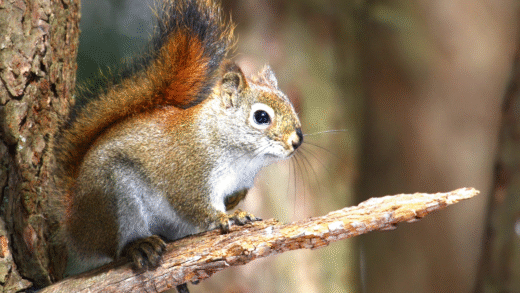Lemurs are unique primates native to Madagascar, with over 100 species exhibiting diverse adaptations for survival. Their historical distribution shows they once roamed wider areas, but isolation led to unique evolution. Today, they face threats like habitat loss and illegal trade, emphasizing the need for robust conservation efforts to protect these vital species and their ecosystems.
What are lemurs?
Lemurs are unique primates that are native to Madagascar. They belong to the infraorder Lemuriformes, which is distinct from monkeys and apes. What sets lemurs apart is their evolutionary history and adaptations. These creatures have large eyes, which help them see well at night, and long tails that aid in balance.
There are over 100 species of lemurs, ranging from the tiny mouse lemur to the larger indri. Their social structures are fascinating too; many species live in matriarchal groups, where females lead the social hierarchy. This is quite different from other primates, where males often dominate.
Historical distribution of lemurs
Historically, lemurs were not confined to Madagascar alone. Fossil evidence suggests that they once roamed across parts of Africa, Europe, and even North America. This wide distribution indicates that lemurs were once more diverse in terms of species and habitats.
Their decline in other regions is attributed to climate changes and competition with other primates, leading to their eventual isolation on Madagascar. This is a classic example of how environmental factors can influence the distribution and evolution of species.
Lemurs in Madagascar
The confinement of lemurs to Madagascar is primarily due to the island’s geographical isolation. Around 160 million years ago, Madagascar broke away from the African continent, creating a unique ecosystem. This isolation led to the evolution of lemurs in ways that are distinctly different from their relatives.
Today, Madagascar serves as a sanctuary for these remarkable creatures. The island’s diverse habitats—from rainforests to dry deciduous forests—support a wide variety of lemur species, each adapted to their specific environment. However, this isolation also makes them vulnerable to extinction due to habitat loss and human activity.
Evolution in Isolation: How Madagascar’s Seclusion Shaped Lemurs
Lemurs evolved in isolation on Madagascar, leading to unique adaptations. This seclusion created an evolutionary playground where lemurs diversified significantly. Over millions of years, they adapted to various habitats on the island, developing distinct traits. For example, some lemurs, like the Ring-tailed Lemur, have developed social behaviors and vocalizations that are vital for communication and group living.
The lack of competing primates allowed lemurs to thrive in niches that would otherwise be filled by other species. This resulted in a variety of lemur species, each with specialized adaptations. Examples of these adaptations include:
- Dietary Specialization: Some lemurs have evolved to eat specific types of leaves, while others are more generalized feeders.
- Behavioral Traits: Certain species exhibit nocturnal habits, allowing them to avoid daytime predators.
- Physical Adaptations: The size and shape of lemur tails vary significantly, aiding in balance and communication.
This evolutionary process illustrates how isolation can lead to rich biodiversity. Madagascar’s unique flora and fauna, shaped by millions of years of evolution, underscores the importance of protecting these habitats to ensure the survival of lemurs.
Modern Lemur Species: What Types of Lemurs are Found in Madagascar Today?
Today, Madagascar is home to over 100 species of lemurs, each exhibiting unique characteristics. These species range in size, color, and behavior, showcasing the incredible diversity of lemurs. Some notable examples include:
- Ring-tailed Lemur: Known for its striking black and white tail, this species is highly social and often found in large groups.
- Indri: The largest living lemur, the Indri has a distinctive vocalization and is known for its tree-dwelling lifestyle.
- Mouse Lemur: As one of the smallest primates in the world, the Mouse Lemur is a nocturnal creature that exhibits fascinating behaviors.
Modern lemurs play crucial roles in their ecosystems, acting as seed dispersers and contributing to forest regeneration. Each species is adapted to specific habitats, from rainforests to dry deciduous forests, showcasing their ecological versatility. The diversity of lemurs highlights the importance of conservation efforts, as many species are threatened by habitat loss and human activities.
Ecosystem Role: What Part Do Lemurs Play in Madagascar’s Ecosystem?
Lemurs are vital to Madagascar’s ecosystem, serving multiple ecological functions. As seed dispersers, they facilitate plant reproduction, ensuring the health of the forest. By consuming fruits and other vegetation, lemurs help maintain plant diversity. Their foraging activities also create pathways in dense foliage, which can benefit other species.
Additionally, lemurs influence insect populations through their feeding habits, contributing to a balanced ecosystem. Their presence supports various food webs, highlighting their importance in maintaining ecological stability. The loss of lemurs could lead to significant changes in Madagascar’s environmental landscape, affecting numerous other species.
Thus, the conservation of lemurs is not only crucial for their survival but also for the overall health of Madagascar’s ecosystems. Protecting these unique primates ensures the continuation of the intricate relationships within their habitats.
Adaptations: How Lemurs Are Suited to Their Environment in Madagascar
Lemurs are fascinating creatures that exhibit a range of adaptations to thrive in Madagascar’s diverse ecosystems. These adaptations are crucial for their survival, allowing them to exploit various resources effectively. One key adaptation is their diet, which varies among species:
- Specialized Feeding: Many lemurs have evolved to consume specific types of leaves, fruits, and flowers, allowing them to occupy unique niches within their habitats.
- Nocturnal Behavior: Some lemurs, like the Mouse Lemur, are nocturnal. This adaptation helps them avoid predators and take advantage of the abundant nighttime resources.
- Physical Traits: The size and shape of lemur tails vary significantly among species, aiding in balance and communication during social interactions.
These adaptations reflect the evolutionary pressures lemurs faced in their isolated environment. For instance, their large eyes enhance night vision, essential for foraging in low-light conditions. Furthermore, their social structures, often matriarchal, have adapted to their ecological needs, fostering cooperation and group living.
Overall, these adaptations demonstrate how lemurs have become highly specialized for life in Madagascar, making them both unique and vulnerable.
Threats to Survival: What Dangers Do Lemurs Face Today?
Lemurs in Madagascar face numerous threats that jeopardize their survival. The most pressing issue is habitat loss due to deforestation. As forests are cleared for agriculture and logging, lemurs lose their natural habitats, leading to population declines. Other significant threats include:
- Illegal Wildlife Trade: Many species are hunted or captured for the pet trade, further reducing their numbers.
- Climate Change: Changes in climate patterns affect food availability and habitat stability, posing additional risks to lemur populations.
- Human-Wildlife Conflict: As human populations grow, interactions with lemurs can lead to conflicts, often resulting in harm to these animals.
These threats highlight the urgent need for conservation efforts to protect lemurs and their habitats. Without immediate action, many species risk extinction.
Conservation Efforts: Why Is It Crucial to Protect Lemurs in Madagascar?
Conservation of lemurs is vital not only for the species themselves but also for the health of Madagascar’s ecosystems. Protecting lemurs ensures the preservation of biodiversity and the ecological roles they play. Key conservation efforts include:
- Protected Areas: Establishing national parks and reserves helps safeguard lemur habitats from deforestation and human encroachment.
- Community Engagement: Involving local communities in conservation efforts fosters sustainable practices and reduces reliance on destructive activities.
- Research and Monitoring: Ongoing studies of lemur populations help track their status and inform conservation strategies.
By supporting these initiatives, we can work towards a future where lemurs thrive in their natural habitats. The survival of these unique primates is intertwined with the health of Madagascar’s ecosystems, making their conservation a shared responsibility.





Comments are closed.